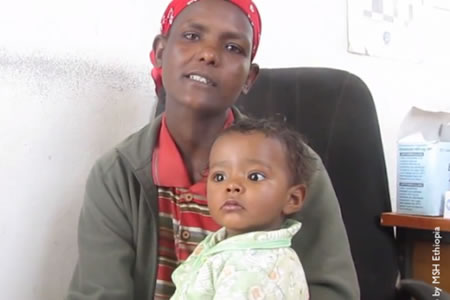Addressing Childhood Tuberculosis: Integration is the Key


“When my daughter got sick, I took her to a clinic in my neighborhood. They gave her cough syrup for seven days. I thought she was getting better, but it was apparent that she was still ill. After another examination, they referred her to St. Paul Hospital in Addis Ababa where they put her on oxygen and started taking blood sample after sample and injection after injection for a month. Her condition did not get better so they gave her another medicine. The doctors then decided to take blood from her back…only then did they know it was tuberculosis.” — Atsede Tefera and her daughter Nigist, photographed at right.
This blog is co-authored by Rudi Thétard and Catherine (Keri) Lijinsky. It was adapted from an original post published in PLoS Blogs.
Tuberculosis (TB) kills more people each year than any other infectious disease, causing over 1.5 million deaths globally in 2014 alone. More than a quarter of cases are in Africa, the region with the highest burden of TB disease relative to population. Children are among the most vulnerable, and all too often children with TB remain in the shadows, undiagnosed, uncounted, and untreated. Today, more than 53 million children worldwide are infected with TB and more than 400 die each day from this preventable and curable disease.
The serious, yet historically neglected, global childhood TB epidemic is preventable through prompt diagnosis and treatment and by reducing risks related to co-morbidities, such as malnutrition, that can make tuberculosis even more lethal to children.
TB is an airborne disease, which is passed between people with active symptoms by coughing or sneezing. TB often spreads in communities where people are living in close proximity to each other, putting those living in poor socio-economic conditions particularly at risk.
In recent years, progress has been made to combat childhood TB. The emergence of policies and guidelines across the Africa region that incorporate childhood TB, coupled with innovative treatment and child-friendly medicine, have moved us closer to tackling one of the oldest and most persistent diseases in the world. However, a new analysis released on World Tuberculosis Day 2016, shows that in African countries, a persistent divide between policy and practice threatens to impede progress gained for addressing childhood TB across the region.
The analysis, a collaboration between the U.S. Agency for International Development (USAID) and its African Strategies for Health (ASH) project, presents the landscape of childhood TB programming in 12 countries in Africa, and suggests three focus areas critical for moving the dial on this intractable issue: (1) Strengthen the capacity of health workers to identify and diagnose children infected with TB. (2) Implement active case finding strategies for early identification of child TB. And (3) Ensure adequate care closer to home.
It is this latter strategy that was the focus of a consultation in New York City in June 2016, sponsored by UNICEF. The intent of this consultation was to contribute to the understanding of integrating childhood TB in the scale-up of community and primary care systems for maternal and child health. Participants looked at country experiences and reflected on key health system functions involved and explored scenarios and implications for research and interventions.
Stay tuned for an upcoming seminar on LeaderNet to continue the conversation informed by the consultation in June.




Responses